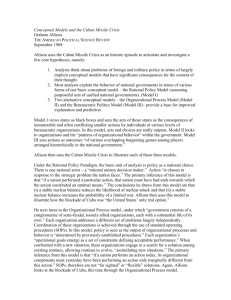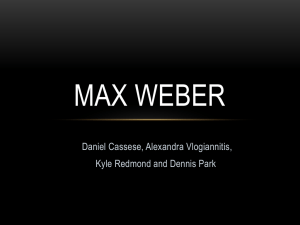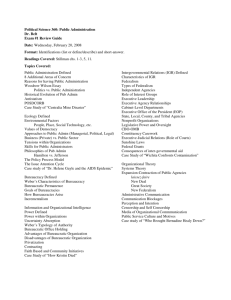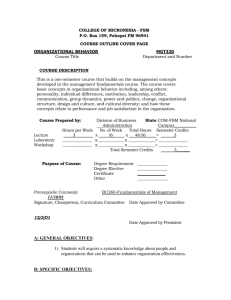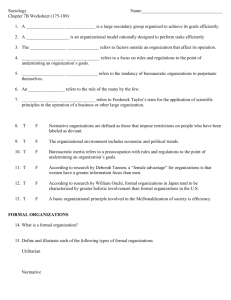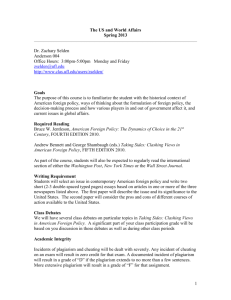Organizational process theory - Political Science, Department of
advertisement
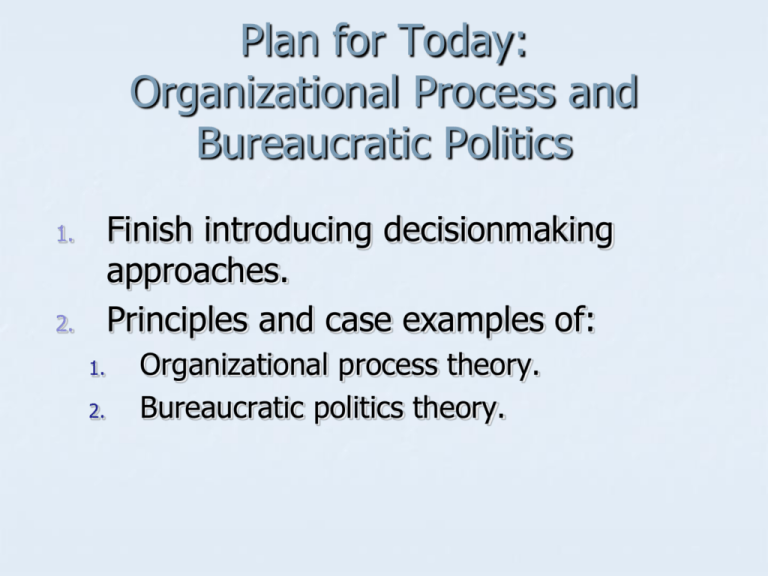
Plan for Today: Organizational Process and Bureaucratic Politics Finish introducing decisionmaking approaches. Principles and case examples of: 1. 2. 1. 2. Organizational process theory. Bureaucratic politics theory. Decisionmaking Approaches: Organizational Process and Bureaucratic Politics Decisionmaking Approaches: Limits to Rationality 1. Personality disorders: decisionmakers may be nuts!! E.g. Saddam Hussein as an egomaniac. George W. Bush as beholden to father or evangelical fanatic. Decisionmaking Approaches: Limits to Rationality Human cognition is limited. 2. Human beings imperfect and biased in processing information. Examples: Prospect theory: people hate losses more than like gains. Jervis: People overestimate extent to which others’ actions are a response to them. Decisionmaking Approaches: Limits to Rationality Huge complexity of decisions: parceled out to complex organizations. 3. 1. 2. Organizations act according to preset repertoires. Organizations occupied by ambitious individuals. Decisionmaking Approaches Two Branches of Theory 1. 2. Organizational process theory. Focuses on the processes at work through standard operating procedures in government and even weapons systems. Bureaucratic politics. Focuses on the clash among bureaucratic actors with conflicting interests. Organizational Process Theory: Setting in Context Allison article: shows differences among: 1. 2. 3. Realist or rationalist perspective (Model I); Organizational process theory (Model II); and Bureaucratic politics (Model III). (Models II & III are decisionmaking approaches) Organizational Process Theory: Setting in Context Model I: Rational Policy or Rational Actor Model. 1. 1. 2. 3. Outcomes of international politics as rational choices of unified national governments. States completely informed, utilitymaximizing actors, and react strategically to events. Obvious identification with realist and neoliberal approaches. Organizational Process Theory: Setting in Context Model II: Organizational Process. 2. 1. 2. Ontology: Governments as “conglomerate of semi-feudal, loosely allied organizations”. Causal argument: Standard operating procedures + imperfect information government organizations suboptimal or unintended policy outputs. Organizational Process Theory: How do Organizations Work? (Allison Model II) 1. 2. Primary responsibility for particular areas necessarily divided. Several organizations within government acting at same time, only partially coordinated, to respond to problems. Organizational Process Theory: How do Organizations Work? (Allison Model II) Governments define alternatives through standard operating procedures (SOPs). 3. 1. 2. 3. 4. Each organization has limited set of SOPs. Orgs “satisfice”: use first minimally acceptable SOP. More complex organization, more it relies on SOPs. Organizations slow to change SOPs to react to new situations. Organizational Process Theory: Sagan’s Depiction of Organizational Failures Theory of “normal accidents” (Perrow): Errors and accidents will be normal occurrence in complex and tightly-coupled systems. “complexity”: how many interrelated branches of activity coming together to create outcome? “coupling”: how much time available between steps to fix problems? Organizational Process Theory: Classification of Organizational Systems/ Processes TIGHTLY COUPLED LOOSELY COUPLED LINEAR COMPLEX Steel mill Nuclear power plant Nuclear weapons systems Department of Motor Vehicles Revenue Canada Universities Organizational Process Theory: Classification of Organizational Systems/ Processes Nuclear weapons systems and nuclear war plans are examples of complex, tightly-coupled systems. E.g. Organizational mistakes during Cuban Missile Crisis: American U2 spy plane lost in Soviet airspace. SAC loaded nukes and conducted scheduled missile test. Bureaucratic Politics: (Allison Model III) Bureaucratic politics: regularized bargaining among players positioned hierarchically within government. Different from organizational process perspective: not routines or failures of systems. Bureaucratic Politics: (Allison Model III) 1. 2. Ontology: leaders of organizations within government are key actors, because occupy critical positions. Causal argument: Outcomes result of bargaining among competitive actors, rather than outputs from limited organizational routines. Bureaucratic Politics: (Allison Model III) Overlap with organizational process theory: Each department or division will have its own biases derived from set of SOPs. SOPs structure the game by predetermining major players and how they can enter game. Bureaucratic Politics: (Allison Model III) “Where you stand depends on where you sit.” Players prefer solutions that serve organization’s power, regardless of national security. Air Force: air attack. State Department: diplomatic negotiation. Defense Department civilians: military action. Military officers: don’t want to enter war they might lose; if attack, prefer preemptive. Bureaucratic Politics: (Allison Model III) For Allison, bureaucrats act in their organization’s interests, rather than for corporations or interest groups. But bureaucrats’ views coloured by personal “baggage,” outside interests, level of ambition. Here lobbyists or past careers can affect them. Bureaucratic Clash over Iraq Ideologues & oil interests? vs Dept. of State – diplomatic “doves” & Military – only invade if can win Dept. of Defense Civilians – gung ho hawks Personal Biases in Model III (Dick Cheney and Iraqi Oil)
